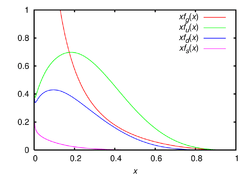Parton (particle physics)
In particle physics, the parton model was proposed by Richard Feynman in 1969 as a way to analyze high-energy hadron collisions.[1] It was later recognized that partons describe the same objects now more commonly referred to as quarks and gluons. Therefore a more detailed presentation of the properties and physical theories pertaining indirectly to partons can be found under quarks.
Model
In this model, a hadron (for example, a proton) is composed of a number of point-like constituents, termed "partons". Additionally, the hadron is in a reference frame where it has infinite momentum — a valid approximation at high energies. Thus, parton motion is slowed by time dilation, and the hadron charge distribution is Lorentz-contracted, so incoming particles will be scattered "instantaneously and incoherently". The parton model was immediately applied to electron/proton deep inelastic scattering by Bjorken and Paschos.[2] Later, with the experimental observation of Bjorken scaling, the validation of the quark model, and the confirmation of asymptotic freedom in quantum chromodynamics, partons were matched to quarks and gluons. The parton model remains a justifiable approximation at high energies, and others have extended the theory over the years.
In the parton model, partons are defined with respect to a physical scale (as probed by the inverse of the momentum transfer). For instance, a quark parton at one length scale can turn out to be a superposition of a quark parton state with a quark parton and a gluon parton state together with other states with more partons at a smaller length scale. Similarly, a gluon parton at one scale can resolve into a superposition of a gluon parton state, a gluon parton and quark-antiquark partons state and other multiparton states. Because of this, the number of partons in a hadron actually goes up with momentum transfer. At low energies (i.e. large length scales), a baryon contains three valence partons (quarks) and a meson contains two valence partons (a quark and an antiquark parton). At higher energies, however, observations show sea partons (nonvalence partons) in addition to valence partons.
Parton distribution functions

A parton distribution function within so called collinear factorization is defined as the probability density for finding a particle with a certain longitudinal momentum fraction x at resolution scale Q2. Because of the inherent non-perturbative nature of partons which can not be observed as free particles, parton densities cannot be fully obtained by perturbative QCD. Within QCD one can, however, study variation of parton density with resolution scale provided by external probe. Such scale is for instance provided by a virtual photon with virtuality Q2 or by a jet. Due to the limitations in present lattice QCD calculations, the known parton distribution functions are instead obtained by fitting observables to experimental data.
Experimentally determined parton distribution functions are available from various groups worldwide. The major unpolarized data sets are:
- ABM by S. Alekhin, J. Bluemlein, S. Moch
- CTEQ, from the CTEQ Collaboration
- GRV/GJR, from M. Glück, P. Jimenez-Delgado, E. Reya, and A. Vogt
- HERA PDFs, by H1 and ZEUS collaborations from the Deutsches Elektronen-Synchrotron center (DESY) in Germany
- MRST/MSTW, from A. D. Martin, R. G. Roberts, W. J. Stirling, R. S. Thorne, and G. Watt
- NNPDF, from the NNPDF Collaboration
The LHAPDF [3] library provides a unified and easy-to-use Fortran/C++ interface to all major PDF sets.
Generalized parton distributions (GPDs) are a more recent approach to better understand hadron structure by representing the parton distributions as functions of more variables, such as the transverse momentum and spin of the parton. Early names included "non-forward", "non-diagonal" or "skewed" parton distributions. They are accessed through exclusive processes for which all particles are detected in the final state. Ordinary parton distribution functions are recovered by setting to zero (forward limit) the extra variables in the generalized parton distributions. Other rules show that the electric form factor, the magnetic form factor, or even the form factors associated to the energy-momentum tensor are also included in the GPDs. A full 3-dimensional image of partons inside hadrons can also be obtained from GPDs.[4]
References
- ↑ Feynman, R. P. (1969). "The Behavior of Hadron Collisions at Extreme Energies". High Energy Collisions: Third International Conference at Stony Brook, N.Y. Gordon & Breach. pp. 237–249. ISBN 978-0-677-13950-0.
- ↑ Bjorken, J.; Paschos, E. (1969). "Inelastic Electron-Proton and γ-Proton Scattering and the Structure of the Nucleon". Physical Review. 185 (5): 1975–1982. Bibcode:1969PhRv..185.1975B. doi:10.1103/PhysRev.185.1975.
- ↑ Whalley, M. R.; Bourilkov, D; Group, R. C. (2005). "The Les Houches accord PDFs (LHAPDF) and LHAGLUE": 8110. arXiv:hep-ph/0508110
 . Bibcode:2005hep.ph....8110W.
. Bibcode:2005hep.ph....8110W. - ↑ Belitsky, A. V.; Radyushkin, A. V. (2005). "Unraveling hadron structure with generalized parton distributions". Physics Reports. 418: 1–387. arXiv:hep-ph/0504030
 . Bibcode:2005PhR...418....1B. doi:10.1016/j.physrep.2005.06.002.
. Bibcode:2005PhR...418....1B. doi:10.1016/j.physrep.2005.06.002.
Further reading
- Glück, M.; Reya, E.; Vogt, A. (1998). "Dynamical Parton Distributions Revisited". European Physical Journal C. 5 (3): 461. arXiv:hep-ph/9806404
 . Bibcode:1998EPJC....5..461G. doi:10.1007/s100529800978.
. Bibcode:1998EPJC....5..461G. doi:10.1007/s100529800978. - Hoodbhoy, P. A. (2006). "Generalized Parton Distributions" (PDF). National Center for Physics and Quaid-e-Azam University. Retrieved 2011-04-06.
- Ji, X. (2004). "Generalized Parton Distributions" (PDF). Annual Review of Nuclear and Particle Science. 54: 413–450. Bibcode:2004ARNPS..54..413J. doi:10.1146/annurev.nucl.54.070103.181302.
- Kretzer, S.; Lai, H.; Olness, F.; Tung, W. (2004). "CTEQ6 Parton Distributions with Heavy Quark Mass Effects". Physical Review D. 69 (11): 114005. arXiv:hep-ph/0307022
 . Bibcode:2004PhRvD..69k4005K. doi:10.1103/PhysRevD.69.114005.
. Bibcode:2004PhRvD..69k4005K. doi:10.1103/PhysRevD.69.114005. - Martin, A. D.; Roberts, R. G.; Stirling, W. J.; Thorne, R. S. (2005). "Parton distributions incorporating QED contributions". European Physical Journal C. 39 (2): 155–161. arXiv:hep-ph/0411040
 . Bibcode:2005EPJC...39..155M. doi:10.1140/epjc/s2004-02088-7.
. Bibcode:2005EPJC...39..155M. doi:10.1140/epjc/s2004-02088-7.
External links
- Parton distribution functions – from HEPDATA: The Durham HEP Databases
- CTEQ6 parton distribution functions